Australia is home to many unique plants and trees! There is so much more about Australian trees that must be explored.
In this article, I will be discussing some of the stunning Australian native trees that you can easily grow in your yard!
No matter where you grow, trees and plants are integral in ecosystems, grasslands, forests, and tundra.
They will provide you with shade, create a habitat, and produce flowers and food for wildlife.
So, let’s explore these low-maintenance native Australian trees and help you grow one in your garden or yard.
7 FAST GROWING LOW MAINTENANCE NEEDED AUSTRALIAN NATIVE TREES
Gum Tree (Eucalyptus)
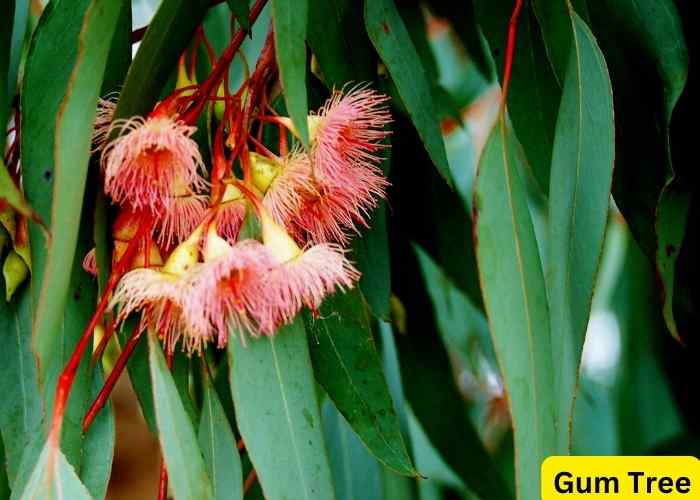
The gum tree belongs to the family Myrtaceae and is commonly considered and found among Australian trees. They are home to iconic wildlife such as koalas.
This evergreen tree is usually found in Southeastern Australia.
There are more than 800 species of Eucalyptus that are cultivated in temperate regions.
Fact: Gum trees are one of the most economically valuable trees.
The flowers of the eucalyptus produce nectar that attracts wild bees, including Stingless bees, resin bees, and many colorful birds.
Tip: If you do not have a spacious area to plant gum trees, plant dwarf varieties up to 30 meters.
Make sure you plant it in well-drained soil and under full sun.
Banksia (Banksia)

Having more than 173 species, Banksias is one of the naturally occurring Australian native trees that add colors to your space.
It blooms and produces flowers of different colors, usually yellow to red. The head/top of the flower looks like thousands of tiny flowers have been jumbled.
The flowers are full of nectar, attracting wild bees, birds, and mammals.
The diverse variety of Banksia is found in western Australia, with around 60 known species.
They produce hard and woody fruits that are grouped together and resemble cones. The hard covering protects the seed from being eaten and burnt.
Interested in growing Banksia in your garden?
They like well-drained soil and full sun. You can maintain it by doing light pruning, but woody rootstock requires heavy pruning.
Bottlebrush (Callistemon)

Callistemon belongs to the family Myrtaceae, and it is cultivated in almost all the regions of Australia. This shrub possesses red brush-shaped flowers that are cylindrical in shape.
If you have a little space and want to grow one of the stunning Australian native trees in the container, a bottlebrush can be the perfect choice.
It requires little to no maintenance and offers a home to possums, flying foxes, insects, lizards, and nectar-loving birds.
This evergreen Australian tree reaches a height of 7 meters and blooms continually between May and September.
It likes warm temperatures so that you can keep it under full sun on your balcony or garden.
Fact Check: If you plan to keep your bottlebrush indoors, do not expect it to produce flowers abundantly.
Wattle (Acacia)

A wattle tree is a great option if you’re looking for fast-growing Australian trees. It is commonly confused with mimosa (as they are closely related to them).
Its genus has around 1350 species (1000 found in Australia), mostly in tropical and subtropical regions.
They are identified through their fragrant yellow or white flowers that are globular or cylindrical structures.
The tree grows fast but lives only for 7 to 12 years, depending on environmental conditions.
They provide food and shelter to Australian birds and bees.
Did you know? Golden Wattle is the national flower of Australia, and the tree is found all around the country by roadsides.
Waratah (Telopea)

The magnificent and big waratah is one of the iconic Australian native trees known for its red showy inflorescence. This popular shrub grows up to 3 to 4 meters tall and blooms during spring.
Fun Fact: Sydney conducts the annual Waratah festival to recognize the beauty of this shrub.
The leaves of the Waratah tree are dark green in color with pointed margins. The tree comes in a white or pink shade, adding beauty to your garden.
The flowers stay bloomed for two weeks.
This easy-to-grow Australian tree can be grown from a stem cutting and placed indoors or outdoors.
Tip: Choose a space more than 2m wide to provide enough space to grow healthily.
You may water it when the soil dries but stop over-watering during winter.
Spider Flower (Grevilleas)

It is a genus of about 360 species that are all evergreens. It is also known as silky oak or toothbrush paint.
They love warm temperatures and have long growing seasons.
The leaves of the Grevillea trees are simple or compound and give a fern-like appearance. The flowers are bright and produce nectar that attracts pollinators.
They grow happily in acidic, well-drained soil with low phosphorous in it.
This drought-tolerant Australian tree likes full to partial sun and can be grown in containers.
They are home to many insects and wild birds that feed on their nectar.
Black She-oak (Allocasuarina)

This evergreen species of flowering plants is one of the biggest Australian native trees. It is not for small gardens; it grows up to 15 meters tall.
This nitrogen-fixing tree returns nutrients to the earth and tolerates varying climate conditions.
Grow it in full sun to help it grow faster.
Do not use sandy soil while growing it, as sandy soil encourages pest growth. Water regularly when it is young. The mature black she-oak does not require regular watering.
3 BEST AUSTRALIAN NATIVE TREES FOR BALCONY
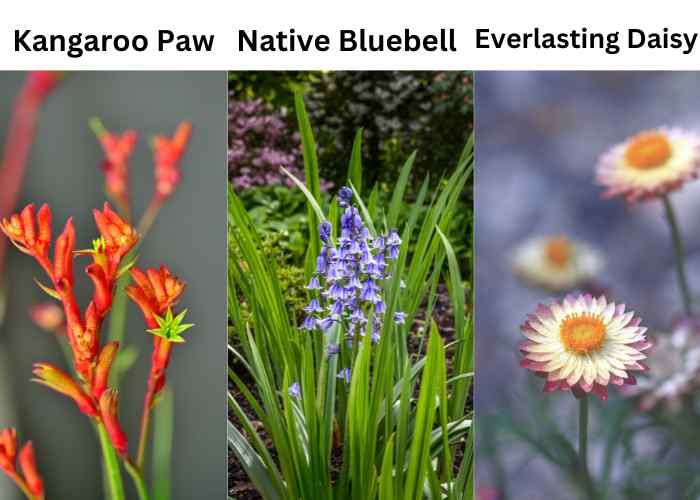
Kangaroo Paw (Anigozanthos)
The plant is named because of its furry flower that looks like a kangaroo paw. This is one of the rare Australian trees and produces red flowers (some species green to pink, yellow, and black).
It does not require high maintenance and can be grown easily by people new to gardening.
They can be grown either in the soil directly or in containers. If you wish to grow it in the container, it is recommended that you choose among dwarf verities.
They prefer full sun (6 hours of direct sunlight) and slightly acidic soil.
Like many other plants, it requires moderate moisture in the soil but avoid over-watering during winter temperatures.
They are full of nectar, making them attractive to birds, insects, and mammals.
Native Bluebell (Wahlembergia Stricta)
Have you seen the beautiful royal blue flowers growing by the roadside? They are Native Bluebells. There are over 13 species of native Bluebells found in Australia, and they all attract butterflies and bees with their nectar.
If you love colors and want to make your balcony attractive, Native bluebell is a must to grow.
They have narrow leaves and flowers on one side of the stem with cream-colored pollen inside. Their flowers have a sweet scent and look eye catchy.
If you have little space on your balcony, you can grow them in hanging baskets under partial sunlight.
Everlasting Daisy (Xerochrysum)
Who does not love daisies? They are among the most attractive plants to grow around the garden or on the balcony.
The flowers of the daisies bloom up to 60mm in diameter and are of multi colors, from white daisies (the most common) to pink and yellow.
They grow both as short-lived perennials or annuals and survive different climatic conditions.
They bloom during spring and leave long-lasting colors. So, do not wait for better plants, and grow daisies on your balcony.
AUSTRALIAN NATIVE FRUIT TREES
Illawarra Plum Tree (Podocarpus Elatus)
This fruit-bearing tree is slow growing and can be grown in a pot. If you grow it in the soil directly, it can reach 40 meters tall.
If you want it to bear fruit, grow one male and a female plant together.
It grows happily under full or partial sunlight and can be grown in different soil types.
If you’re living around the coast and are looking for tall Australian native trees, the Illawarra plum tree is the best choice.
Tucker Bush Cherry Tree
You might be familiar with Lilly pillies, and the tucker bush cherry tree is a fruit-bearing variety of Lilly Pilly.
It blooms from late spring to early summer and produces white clusters of flowers that become fruit later. Its fruit has an apple-like texture but tastes a bit acidic.
It is usually found in rainforests and can be grown in all soil types.
It happily grows under full sun, and its bronze oval leaves turn green when mature.
Do pruning regularly to maintain its shape, size, and appearance.
AUSTRALIAN NATIVE SCREEN TREES
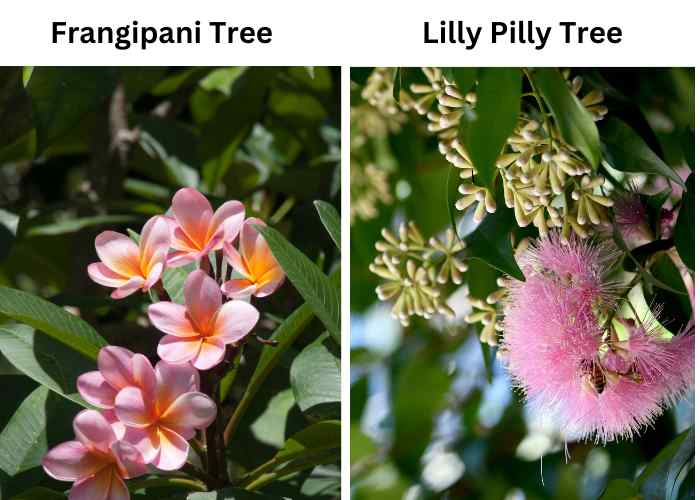
Native Frangipani Tree (Plumeria)
Frangipani trees (genus Plumeria) are one of the Australian native trees that are cultivated as ornamental in bit warmer climates. They possess beautiful fragrant flowers and are easy to grow from cuttings.
The beautiful fragrant frangipani tree blooms flowers for months, making it more attractive than other flowering trees. It is easy to care for and produces multi-colored flowers.
Water the frangipani cuttings once every week during the summers. And you may skip watering during the winters.
Keep the cutting warm to grow it well, and apply high-potassium fertilizer when the tree matures.
Lilly Pilly Tree
These Australian native trees belong to the Myrtle family and are native to Down Under, Australia.
They come in various species, each with distinctive characteristics and charm.
They have a dense leaf network that serves the purpose of a privacy screen and ornamental accent.
Lilly pilly trees produce fragrant white flowers that turn into berries later.
It does not require much maintenance and can tolerate drought or occasional overwatering.
THAT’S A WRAP!
This article covers the types of trees in Australia, including fast-growing low, maintenance-needed Australian native trees, trees for balconies, Australian native fruit trees, and Australian screen trees.
Most trees are easy to grow and need little to no maintenance.
Few grow fast, and few are slow growing; some of them bear fruit as well.
If you want to add beauty to your garden, balcony, or space, or attract wild bees, birds, and butterflies to them, grow them and enjoy!
Have you got more questions? Here are the answers to the most frequently asked questions.
FREQUENTLY ASKED QUESTIONS
Suggest a few Australian native plants.
Gum tree (Eucalyptus)
Banksia (Banksia)
Bottlebrush (Callistemon)
Wattle (Acacia)
Waratah (Telopea)
Spider flower (Grevilleas)
Kangaroo Paw (Anigozanthos)
Native Bluebell (Wahlenbergia Stricta)
Everlasting daisy (Xerochrysum)
Black she-oak (Allocasuarina)
Illawarra Plum Tree (Podocarpus Elatus)
Tucker Bush Cherry Tree
Native Frangipani Tree (Plumeria)
Lilly Pilly Tree
Suggest Australian native trees with non-invasive roots.
Native Frangipani Tree (Plumeria)
Australian Willow (Geijera parviflora)
Lemon Myrtle (Backhousia citriodora)
Suggest a few Australian native evergreen trees.
Gum tree (Eucalyptus)
Bottlebrush (Callistemon)
Banksia (Banksia)
Follow @kitchenandgardening for more!



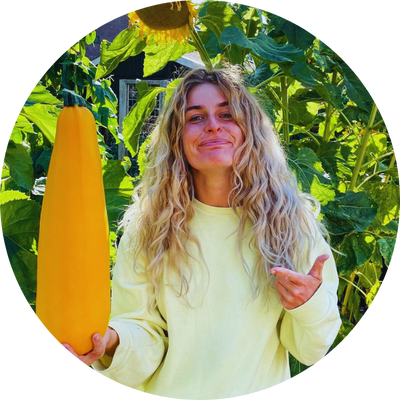

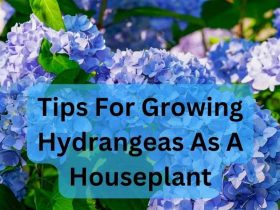


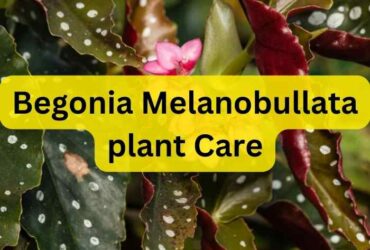

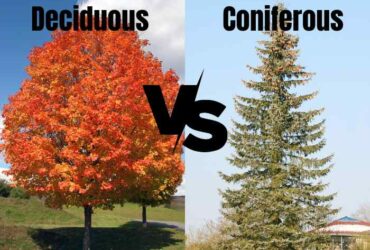



Leave a Reply